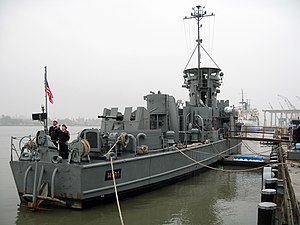HTMS Nakha

USS LCS(L) 102 at Vallejo, California, 2007
|
|
| History | |
|---|---|
|
|
|
| Name: | USS LCS(L)(3)-102 |
| Laid down: | 13 January 1945 |
| Launched: | 3 February 1945 |
| Commissioned: | 17 February 1945 |
| Reclassified: | Redesignated, USS LSSL-102 28 February 1949 |
| Fate: | Transferred 30 April 1953 |
| Honors and awards: |
one battle star |
|
|
|
| Name: | JDS Himawari |
| Acquired: | 30 April 1953 |
| Out of service: | 1966 |
| Fate: | Transferred to Thailand on 18 April 1966 |
|
|
|
| Name: | HTMS Nakha (LSSL-751) |
| Acquired: | 1966 |
| Out of service: | 2007 |
| Fate: | Returned to the US |
| Notes: | Became a museum ship September 2007 |
| General characteristics | |
| Class and type: | LCS(L)(3)-1 Class Landing Craft Support ship |
| Displacement: |
|
| Length: | 158 ft (48 m) |
| Beam: | 23 ft 8 in (7.21 m) |
| Draft: | 5 ft 8 in (1.73 m) |
| Propulsion: | Diesel engines |
| Speed: | 16.5 knots (max); 12 knots (econ) |
| Range: | 5,500 nautical miles at 12 knots |
| Complement: | 8 officers, 70 enlisted |
| Armament: |
|
| Armor: | 10-lb. STS splinter shields |
|
|
|
| Location | Vallejo, California |
| NRHP Reference # | 15000716 |
| Added to NRHP | October 13, 2015 |
USS LCS(L)(3)-102 is an LCS(L)(3)-1 Class Landing Craft Support ship built for the United States Navy during World War II. The vessel was completed near the end of the war and saw brief service during the Battle of Okinawa. After the war, LCS(L)(3)-102 served in China before being decommissioned in 1946 and then transferred to Japan in mid-1953. Serving under the name JDS Himawari, the vessel remained in Japan until mid-1966 when she was transferred to Thailand, becoming the HTMS Nakha. In 2007, after being retired, the ship was returned to the United States to become museum ship.
USS LCS(L)(3)-102 was laid down 13 January 1945 at Commercial Iron Works in Portland, Oregon. The vessel was launched on 3 February 1945 and commissioned on 17 February. As built, the vessel displaced 250-tons without load, and 387 tons at full load. She was 158 feet (48 m) long, with a beam of 23 feet 6 inches (7.16 m) and a draft of 5 feet 8 inches (1.73 m). With a crew of six officers and 65 enlisted personnel, at maximum endurance she had a range of 5,500 nautical miles at a cruising speed of 12 knots; power was provided by two propellers that were driven by two General Motors 6-71 four-shaft 1,600 horse power diesel engines. She was armed with an array of weapons, including: a single 3-inch gun mounted on her bow; two twin-mounted 40mm anti-aircraft guns; four single-mounted 20mm anti-aircraft guns; four .50 caliber machine-guns and ten rocket launchers. Armor included 10-pound (4.5 kg) splinter shields which were placed on the gun mounts, the pilot house and the conning tower.
After commissioning, "LCS(L)(3)-102" was assigned to the Asiatic-Pacific Theater under the command of Lt. Richard L. Jones. World War II was in its final stages at the time, but she arrived in time to participate in the Battle of Okinawa, participating in the Gunto operation between 18 and 30 June 1945.
She was pulled off line to perform mine removal in the Philippines, before doing the same in the Marshal Islands, Mariana Islands, and rivers in China.
At the end the end of the war, USS LCS(L)(3)-102 served as part of the occupation forces in Japan until December 1945 when it was moved to China before being deemed surplus and decommissioned in April 1946 and laid up in the Pacific Reserve Fleet, Columbia River Group, in Astoria, Oregon. Redesignated Landing Ship Support Large, USS "LSSL-102", on 28 February 1949 she was soon transferred to Japan, 30 April 1953, and renamed JDS Himawari where she served until 18 April 1966 when she was brought to the US, re-transferred to Thailand and renamed HTMS Nakha (LSSL-751). She stayed in Thailand until 2007.
...
Wikipedia
